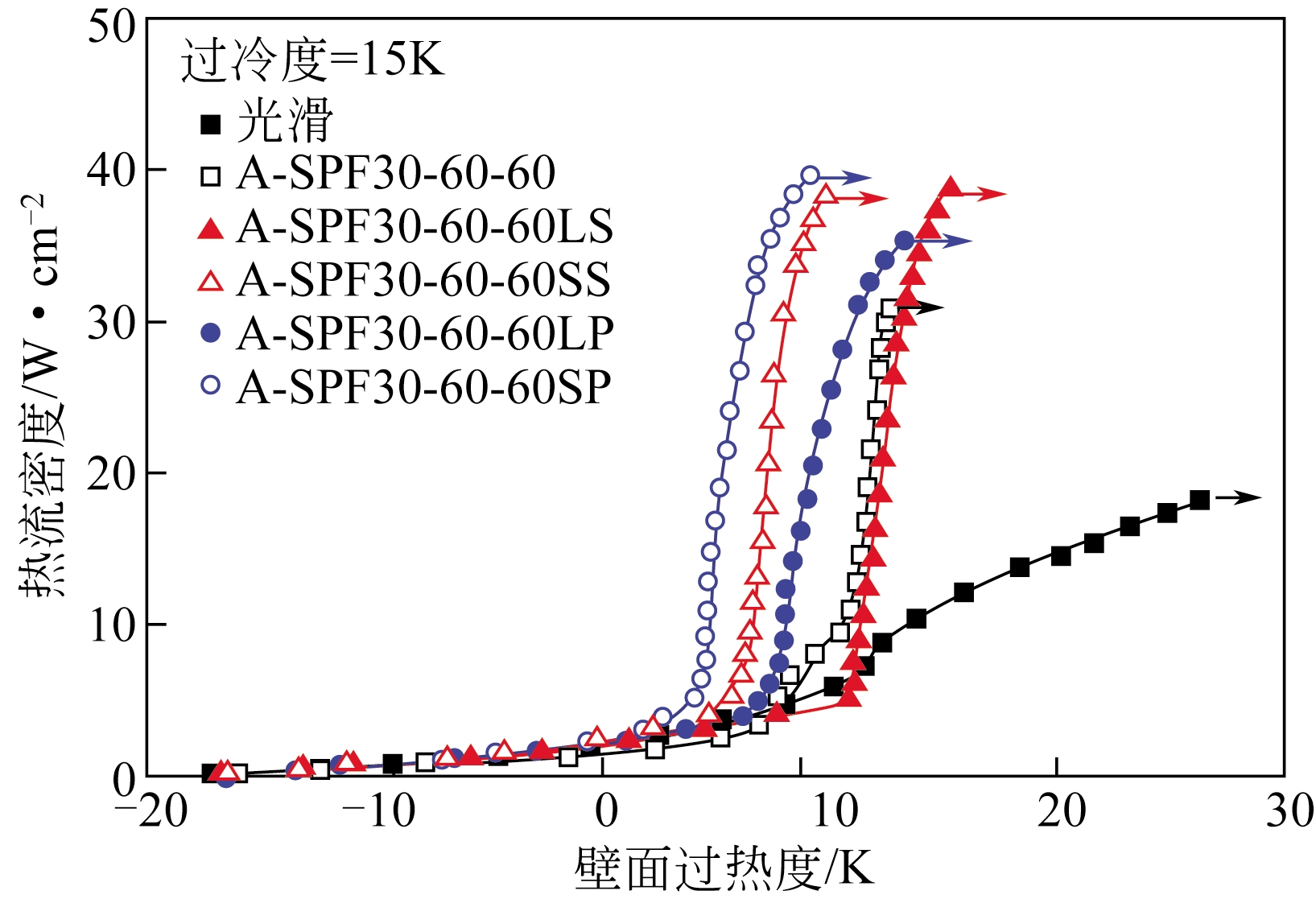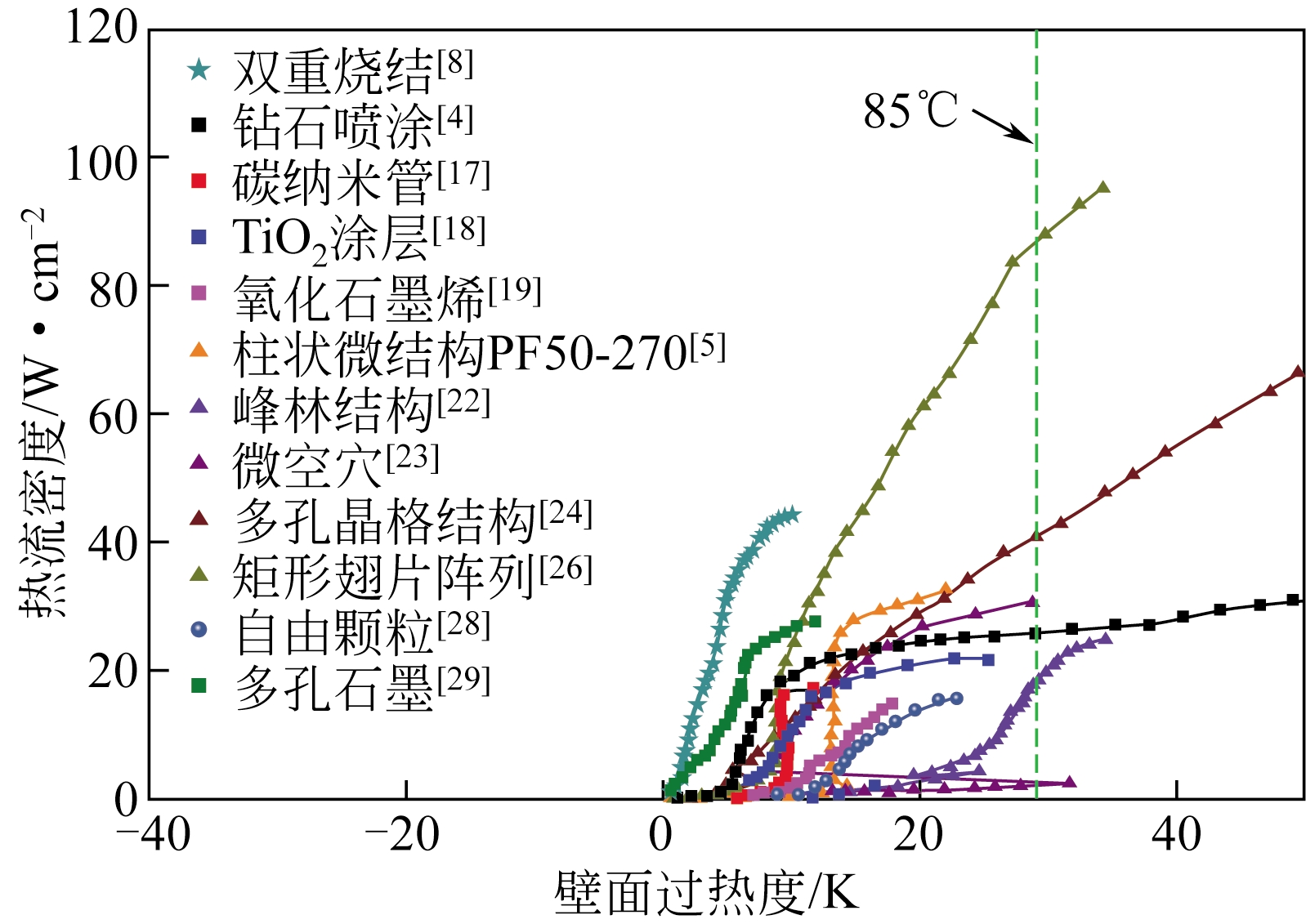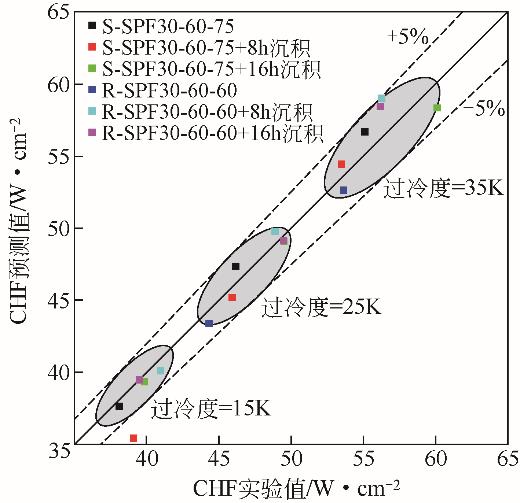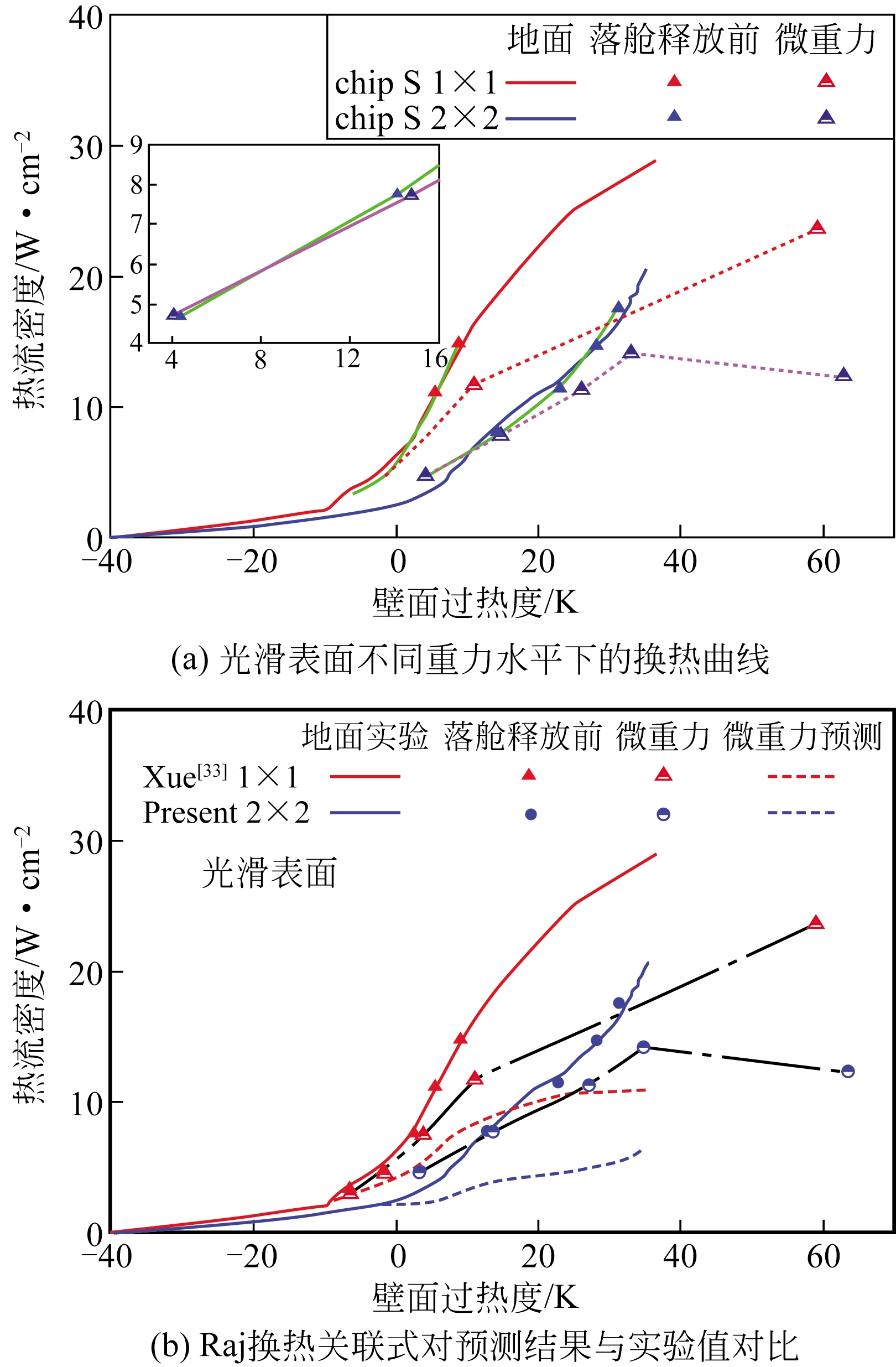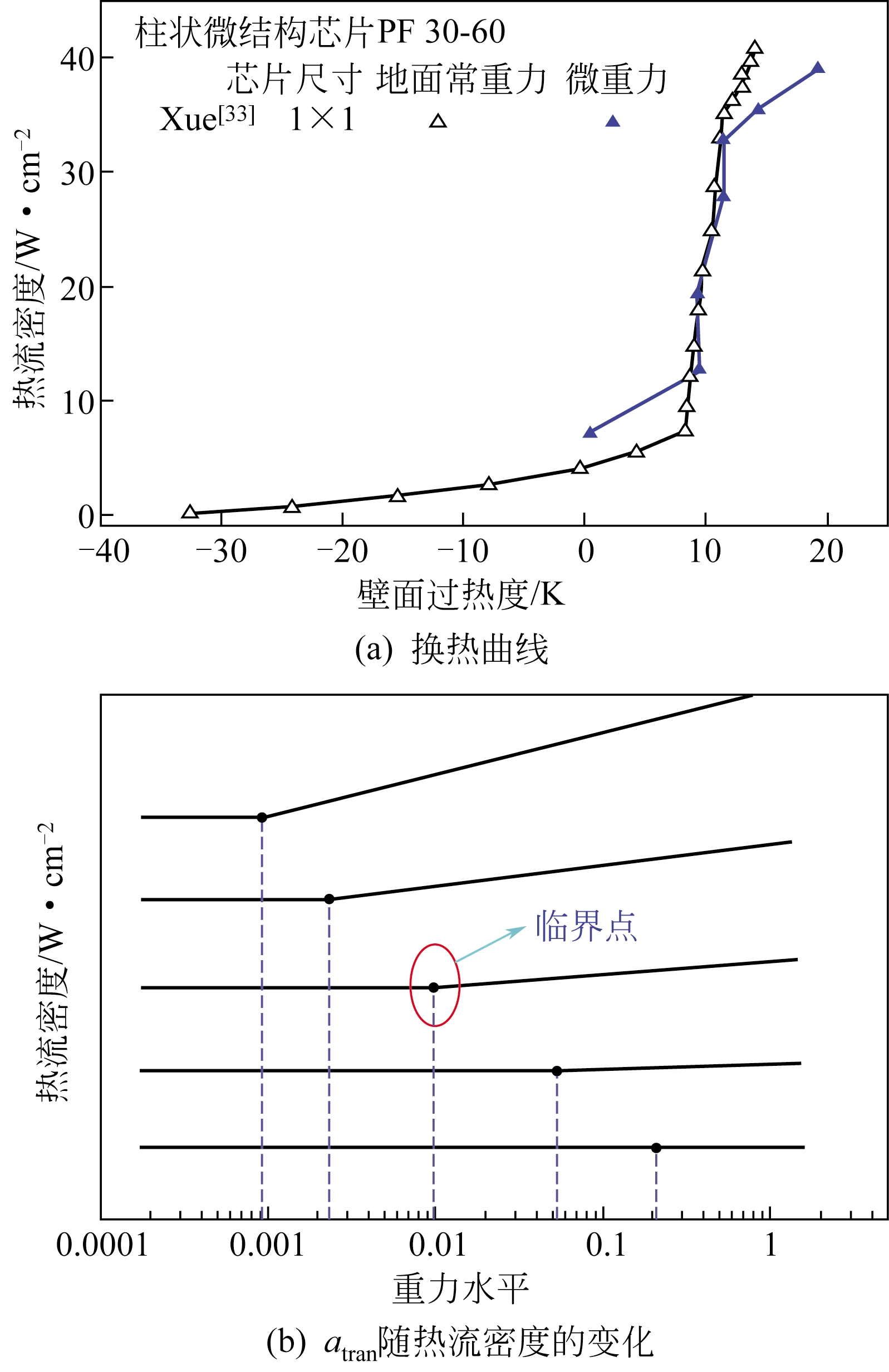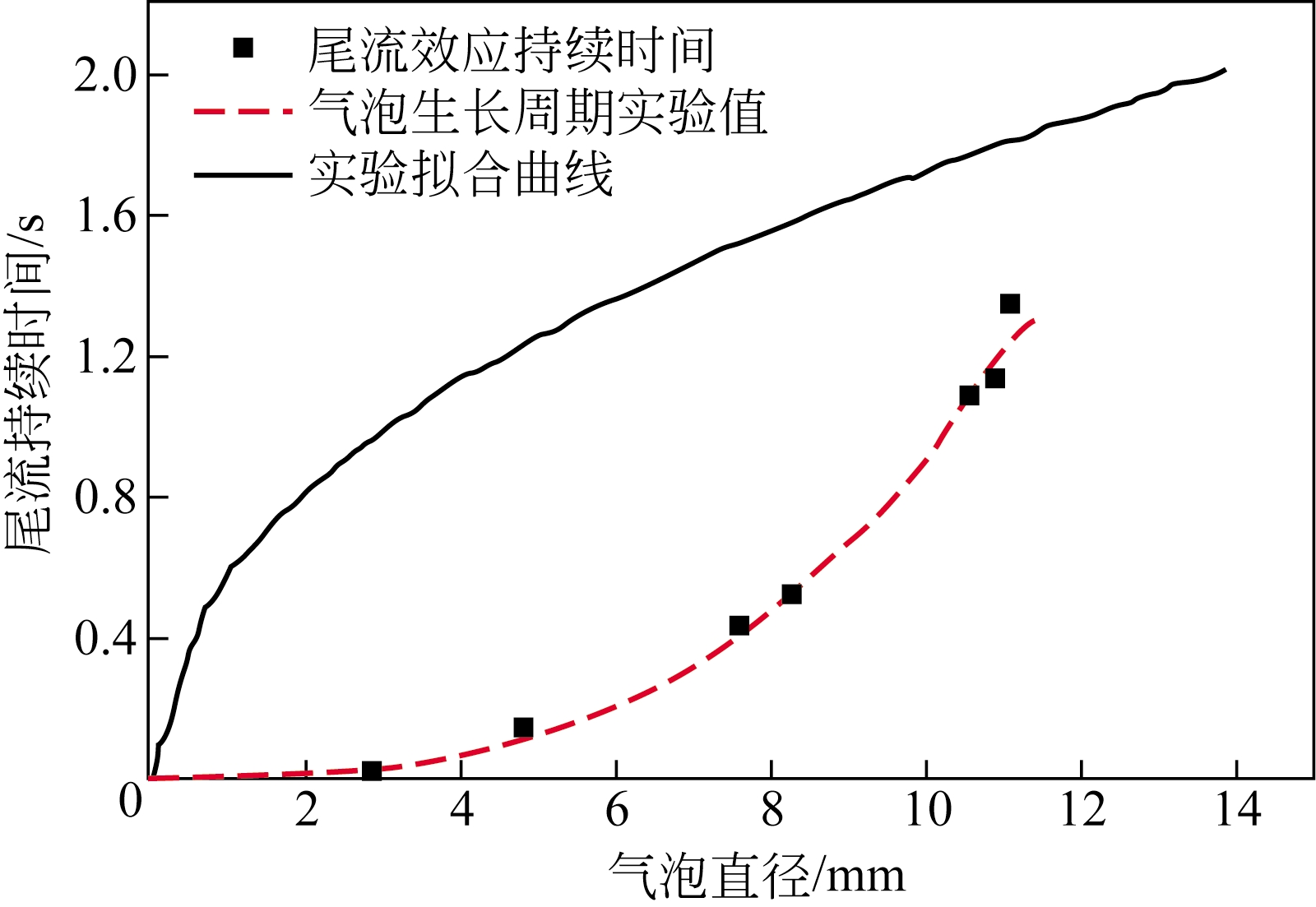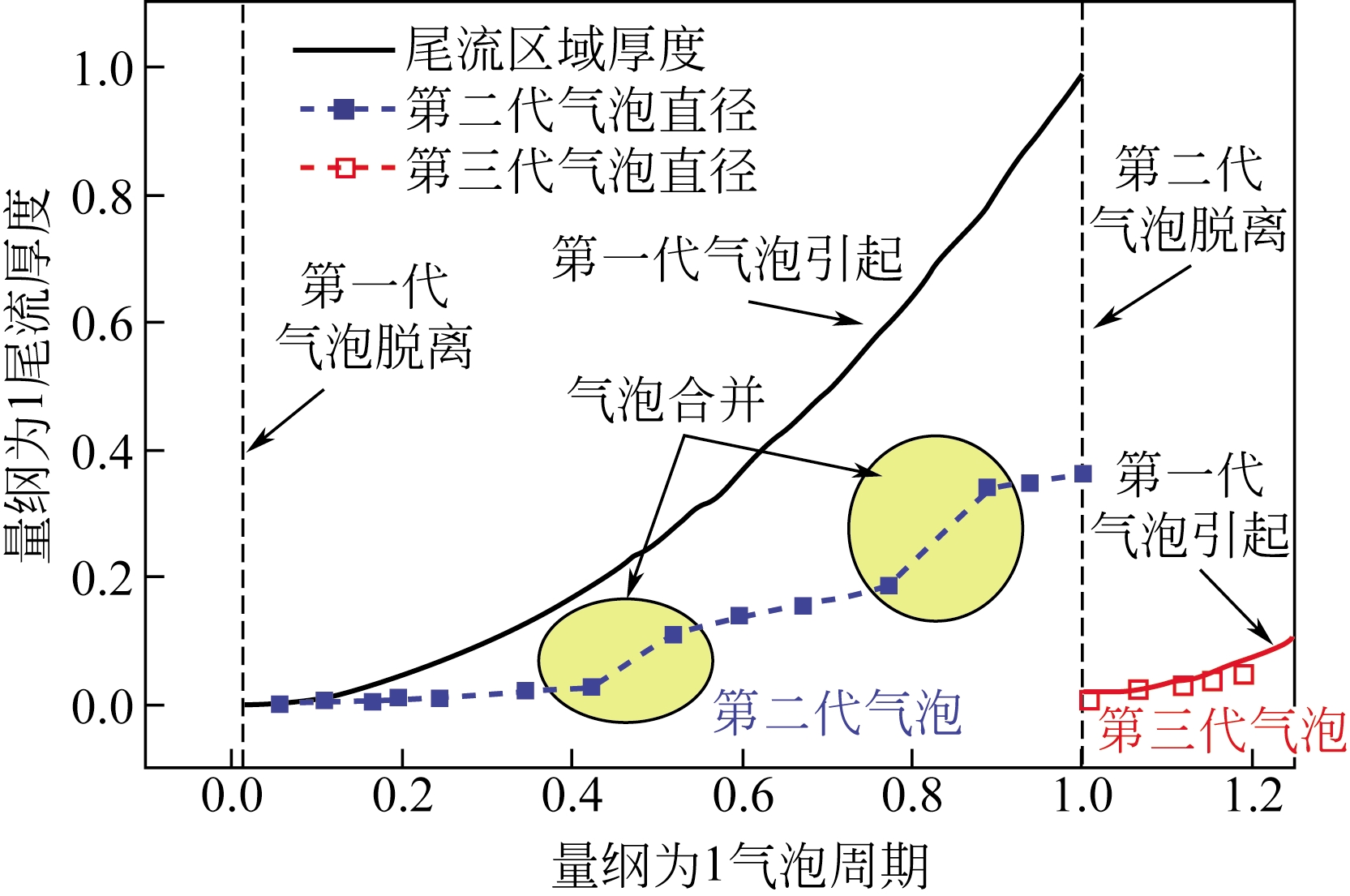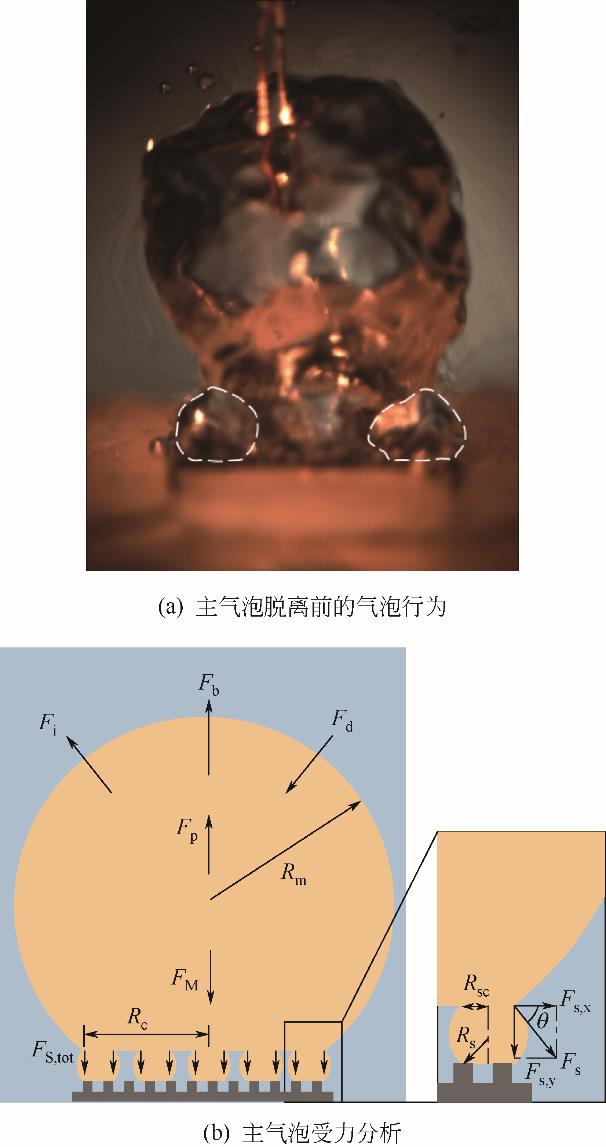化工进展 ›› 2019, Vol. 38 ›› Issue (01): 14-29.DOI: 10.16085/j.issn.1000-6613.2018-1133
常/微重力下微结构表面强化沸腾换热研究进展
- 1. 西安交通大学化学工程与技术学院,陕西 西安 710049
2. 西安交通大学动力工程多相流国家重点实验室,陕西 西安 710049
-
收稿日期:2018-05-31修回日期:2018-07-24出版日期:2019-01-05发布日期:2019-01-05 -
作者简介:魏进家(1971—),男,博士,教授,博士生导师,研究方向为多相流与传热。E-mail:<email>jjwei@mail.xjtu.edu.cn</email>。 -
基金资助:国家自然科学基金(51636006,51611130060,51506169);国家自然科学基金(51636006,51611130060,51506169)。
Jinjia WEI1,2( ),Bin LIU1,Yonghai ZHANG1
),Bin LIU1,Yonghai ZHANG1
- 1. School of Chemical Engineering and Technology, Xi’an Jiaotong University, Xi’an 710049, Shaanxi, China
2. State Key Laboratory of Multiphase Flow in Power Engineering, Xi’an Jiaotong University, Xi’an 710049, Shaanxi, China
-
Received:2018-05-31Revised:2018-07-24Online:2019-01-05Published:2019-01-05
摘要:
表面改性是提高沸腾换热性能的重要手段。本文以自主开发的微结构表面为基础,简述了近三年来常重力条件下的微/纳结构表面强化池沸腾换热、临界热流密度预测模型及经验关联、微重力条件下(重力水平为10-2~10-3 g 0,g 0=9.8m/s2)加热面尺寸对沸腾换热的影响和气泡动力学等方面的研究进展。对柱状微结构参数和排布方式进行优化后的多尺度复合微结构表面相比柱状微结构表面和光滑表面,其壁面温度可分别降低8K和30K以上,而临界热流密度(CHF)则分别提高了28%和119%以上。体积分数为0.02%的乙醇/银纳米流体相对于单纯的乙醇工质,相同条件下换热壁面温度可降低8~15K,而机械作用对CHF约有25%的提高。通过对柱状微结构的几何参数以及临界发生时的供液机理研究,建立了考虑柱状微结构参数的CHF关联式、微/纳结构表面考虑液体毛细芯吸作用的CHF预测模型以及考虑液体铺展速度的CHF预测关联式。根据微重力下加热面尺寸对沸腾的影响的研究,提出了基于恒定热流密度的换热预测关联式。考虑微重力条件下主气泡和小气泡的表面张力,对传统的气泡脱离直径预测的力平衡模型进行了改进,进一步提高了微重力下气泡的脱离半径的预测精度。此外,对近年来以FC-72为工质的其他强化池沸腾换热微结构表面的研究成果进行了总结,并与自主研发的微结构表面换热性能进行了对比与分析,为今后的研究方向和应用指出了方向。
中图分类号:
引用本文
魏进家, 刘斌, 张永海. 常/微重力下微结构表面强化沸腾换热研究进展[J]. 化工进展, 2019, 38(01): 14-29.
Jinjia WEI, Bin LIU, Yonghai ZHANG. [J]. Chemical Industry and Engineering Progress, 2019, 38(01): 14-29.
| 硅片 | 柱宽(直径)b/μm | 柱高h/μm | 柱间距p/μm | h/p | 面积强化比A PF/A S | 孔隙率φ |
|---|---|---|---|---|---|---|
| A-SPF30-60-60 | 30 | 60 | 60 | 1.0 | 3.00 | 0.75 |
| S-SPF30-60-60 | 30 | 60 | 60 | 1.0 | 3.00 | 0.75 |
| S-SPF30-60-75 | 30 | 60 | 75 | 0.8 | 2.28 | 0.84 |
| S-SPF30-60-45 | 30 | 60 | 45 | 1.3 | 4.56 | 0.56 |
| S-CPF38-60-60 | 38.22 | 60 | 60 | 1.0 | 3.00 | 0.68 |
| R-SPF30-60-60 | 30 | 60 | 60 | 1.0 | 2.33 | 0.83 |
| A-SPF30-60-60LS | 30 | 60 | — | — | 2.40 | 0.82 |
| A-SPF30-60-60SS | 30 | 60 | — | — | 2.40 | 0.82 |
| A-SPF30-60-60LP | 30 | 60 | — | — | 1.98 | 0.88 |
| A-SPF30-60-60SP | 30 | 60 | — | — | 1.98 | 0.88 |
表1 柱状微结构表面几何参数表
| 硅片 | 柱宽(直径)b/μm | 柱高h/μm | 柱间距p/μm | h/p | 面积强化比A PF/A S | 孔隙率φ |
|---|---|---|---|---|---|---|
| A-SPF30-60-60 | 30 | 60 | 60 | 1.0 | 3.00 | 0.75 |
| S-SPF30-60-60 | 30 | 60 | 60 | 1.0 | 3.00 | 0.75 |
| S-SPF30-60-75 | 30 | 60 | 75 | 0.8 | 2.28 | 0.84 |
| S-SPF30-60-45 | 30 | 60 | 45 | 1.3 | 4.56 | 0.56 |
| S-CPF38-60-60 | 38.22 | 60 | 60 | 1.0 | 3.00 | 0.68 |
| R-SPF30-60-60 | 30 | 60 | 60 | 1.0 | 2.33 | 0.83 |
| A-SPF30-60-60LS | 30 | 60 | — | — | 2.40 | 0.82 |
| A-SPF30-60-60SS | 30 | 60 | — | — | 2.40 | 0.82 |
| A-SPF30-60-60LP | 30 | 60 | — | — | 1.98 | 0.88 |
| A-SPF30-60-60SP | 30 | 60 | — | — | 1.98 | 0.88 |
| 研究者 | 表面特征 | 测试工况 | 沸腾换热性能与光滑表面的比较 |
|---|---|---|---|
| McHale和 Garimella[ | 粗糙表面 Ra =4.25~5.17μm | ΔT sub=0K 测试条尺寸: 长25mm,宽400μm | CHF提升24%(41W/cm2) 沸腾起始温度过热度~16K |
| Byon等[ | 双重多孔烧结表面 双重粒径分别为100μm和675μm 涂层厚度为1mm | ΔT sub=0K 铜块厚度5mm,直径10mm | CHF提升182%(44.5W/cm2) 沸腾起始温度过热度~1.4K |
| O’Connor等[ | 金刚石喷涂表面 子粒径为8~12μm 涂层厚度为40~45μm | ΔT sub=0K 矩形加热面尺寸: 长 1.65cm,宽0.5cm | CHF提升比103% 沸腾起始温度过热度~5K |
| Ujereh等[ | 碳纳米管涂层表面 碳纳米管密度为10CNTs/μm2 | ΔT sub=0K 加热面尺寸: 长 12.7mm,宽12.7mm | CHF提升比45%(18.1W/cm2) 沸腾起始温度过热度~7.9K HTC提升452% |
| Wu等[ | TiO2涂层表面 涂层厚度约为1mm Ra =1.55μm | ΔT sub=0K 加热面尺寸: 长10mm,宽10mm,高2mm | CHF提升比38.2%(22.8W/cm2) 沸腾起始温度过热度~7K |
| Ho等[ | 碳纳米管涂层表面 涂层厚度215μm | ΔT sub=0K 角度=0°,30°,60°,120°,150°和180° 加热面尺寸: 长10mm,宽10mm,高20mm | CHF提升比42%(20.1W/cm2) 沸腾起始温度过热度~10K HTC提升86% |
| Slomski等[ | CrN涂层表面 Ra =0.019μm 微晶尺寸157.69nm | ΔT sub=0K 铜加热块直径10mm | CHF提升156%(15.0W/cm2) 沸腾起始温度过热度~12.5K HTC提升120% |
| An等[ | 氧化石墨烯薄膜表面 Ra=95nm | ΔT sub=0K 石墨薄膜加热器面积3cm2 | CHF提升50%(15.0W/cm2) 沸腾起始温度过热度~8K HTC提升150% |
| Wei和Honda[ | 柱状微结构表面 微柱长50μm,宽50μm,高270μm | ΔT sub= 0,15,25,35,45K 加热面尺寸: 长10mm,宽10mm,厚0.5mm | CHF (ΔT sub=0K), 提升102%(32.6W/cm2) 沸腾起始温度过热度~12.8K CHF(ΔT sub=45K),提升320%(84.5W/cm2) 沸腾起始温度过热度~12.0K |
| Bon等[ | 峰林结构表面 尺寸10μm,间距3μm | ΔT sub=0K 加热器直径38.1mm | CHF提升48% 沸腾起始温度过热度~18K |
| Yu等[ | 微孔穴表面 孔直径为200μm,深度为110μm, 孔中心距距为300μm | ΔT sub=0K 加热硅片尺寸: 长10mm,宽10mm,厚625μm | CHF提升150%(30W/cm2) 沸腾起始温度过热度~8K |
| Ho等[ | 选择性激光熔化加工微柱表面 微柱在表面为15×15的阵列排布 微柱直径350μm,高度550μm, 微柱中心距600μm | ΔT sub=0K CHF提升比76%(47.9W/cm2) 加热硅片尺寸: 长10mm,宽10mm,厚1mm | CHF提升比76%(47.9W/cm2) 沸腾起始温度过热度~10K HTC提升47% |
| Wong等[ | 选择性激光熔化加工多孔晶格表面 多孔晶格单元尺寸5mm,高度5mm | ΔT sub=0K 加热硅片尺寸: 长10mm,宽10mm,厚5mm | CHF提升比511%(107W/cm2) 沸腾起始温度过热度~10K HTC提升158% |
| Yu等[ | 矩形翅片阵列表面 方形翅片宽度0.5mm 翅片高度4mm | ΔT sub=0K 加热片尺寸: 长10mm,宽10mm,厚4mm | CHF提升比443%(98.3W/cm2) 沸腾起始温度过热度~8K |
| Kim等[ | 自由颗粒沉积表面 粒子直径10μm 粒子总质量0.2g | ΔT sub=0K 加热面尺寸: 长25.4mm,宽25.4mm | CHF提升比10% 沸腾起始温度过热度~12K HTC提升76.3% |
| Sarangi等[ | 自由颗粒沉积表面 粒径45~53μm 重量1.18g | ΔT sub=0K 加热面尺寸: 长25.4mm,宽25.4mm | CHF提升比44%(16.1W/cm2) 沸腾起始温度过热度~13K |
| Parker和 El-Genk[ | 石墨多孔多尺度复合表面 微孔尺度1μm至数百微米 多孔层厚度1.6mm | ΔT sub=0K,10K,20K,30K 石墨加热器尺寸: 长10mm,宽10mm,厚3.0mm | CHF(饱和)提升62%(27.3W/cm2) 沸腾起始温度过热度~0.5K CHF(ΔT sub=30K)提升94%(57.1W/cm2) 沸腾起始温度过热度~0.5K |
表2 以FC-72为实验工质常压下的强化换热表面实验研究总结
| 研究者 | 表面特征 | 测试工况 | 沸腾换热性能与光滑表面的比较 |
|---|---|---|---|
| McHale和 Garimella[ | 粗糙表面 Ra =4.25~5.17μm | ΔT sub=0K 测试条尺寸: 长25mm,宽400μm | CHF提升24%(41W/cm2) 沸腾起始温度过热度~16K |
| Byon等[ | 双重多孔烧结表面 双重粒径分别为100μm和675μm 涂层厚度为1mm | ΔT sub=0K 铜块厚度5mm,直径10mm | CHF提升182%(44.5W/cm2) 沸腾起始温度过热度~1.4K |
| O’Connor等[ | 金刚石喷涂表面 子粒径为8~12μm 涂层厚度为40~45μm | ΔT sub=0K 矩形加热面尺寸: 长 1.65cm,宽0.5cm | CHF提升比103% 沸腾起始温度过热度~5K |
| Ujereh等[ | 碳纳米管涂层表面 碳纳米管密度为10CNTs/μm2 | ΔT sub=0K 加热面尺寸: 长 12.7mm,宽12.7mm | CHF提升比45%(18.1W/cm2) 沸腾起始温度过热度~7.9K HTC提升452% |
| Wu等[ | TiO2涂层表面 涂层厚度约为1mm Ra =1.55μm | ΔT sub=0K 加热面尺寸: 长10mm,宽10mm,高2mm | CHF提升比38.2%(22.8W/cm2) 沸腾起始温度过热度~7K |
| Ho等[ | 碳纳米管涂层表面 涂层厚度215μm | ΔT sub=0K 角度=0°,30°,60°,120°,150°和180° 加热面尺寸: 长10mm,宽10mm,高20mm | CHF提升比42%(20.1W/cm2) 沸腾起始温度过热度~10K HTC提升86% |
| Slomski等[ | CrN涂层表面 Ra =0.019μm 微晶尺寸157.69nm | ΔT sub=0K 铜加热块直径10mm | CHF提升156%(15.0W/cm2) 沸腾起始温度过热度~12.5K HTC提升120% |
| An等[ | 氧化石墨烯薄膜表面 Ra=95nm | ΔT sub=0K 石墨薄膜加热器面积3cm2 | CHF提升50%(15.0W/cm2) 沸腾起始温度过热度~8K HTC提升150% |
| Wei和Honda[ | 柱状微结构表面 微柱长50μm,宽50μm,高270μm | ΔT sub= 0,15,25,35,45K 加热面尺寸: 长10mm,宽10mm,厚0.5mm | CHF (ΔT sub=0K), 提升102%(32.6W/cm2) 沸腾起始温度过热度~12.8K CHF(ΔT sub=45K),提升320%(84.5W/cm2) 沸腾起始温度过热度~12.0K |
| Bon等[ | 峰林结构表面 尺寸10μm,间距3μm | ΔT sub=0K 加热器直径38.1mm | CHF提升48% 沸腾起始温度过热度~18K |
| Yu等[ | 微孔穴表面 孔直径为200μm,深度为110μm, 孔中心距距为300μm | ΔT sub=0K 加热硅片尺寸: 长10mm,宽10mm,厚625μm | CHF提升150%(30W/cm2) 沸腾起始温度过热度~8K |
| Ho等[ | 选择性激光熔化加工微柱表面 微柱在表面为15×15的阵列排布 微柱直径350μm,高度550μm, 微柱中心距600μm | ΔT sub=0K CHF提升比76%(47.9W/cm2) 加热硅片尺寸: 长10mm,宽10mm,厚1mm | CHF提升比76%(47.9W/cm2) 沸腾起始温度过热度~10K HTC提升47% |
| Wong等[ | 选择性激光熔化加工多孔晶格表面 多孔晶格单元尺寸5mm,高度5mm | ΔT sub=0K 加热硅片尺寸: 长10mm,宽10mm,厚5mm | CHF提升比511%(107W/cm2) 沸腾起始温度过热度~10K HTC提升158% |
| Yu等[ | 矩形翅片阵列表面 方形翅片宽度0.5mm 翅片高度4mm | ΔT sub=0K 加热片尺寸: 长10mm,宽10mm,厚4mm | CHF提升比443%(98.3W/cm2) 沸腾起始温度过热度~8K |
| Kim等[ | 自由颗粒沉积表面 粒子直径10μm 粒子总质量0.2g | ΔT sub=0K 加热面尺寸: 长25.4mm,宽25.4mm | CHF提升比10% 沸腾起始温度过热度~12K HTC提升76.3% |
| Sarangi等[ | 自由颗粒沉积表面 粒径45~53μm 重量1.18g | ΔT sub=0K 加热面尺寸: 长25.4mm,宽25.4mm | CHF提升比44%(16.1W/cm2) 沸腾起始温度过热度~13K |
| Parker和 El-Genk[ | 石墨多孔多尺度复合表面 微孔尺度1μm至数百微米 多孔层厚度1.6mm | ΔT sub=0K,10K,20K,30K 石墨加热器尺寸: 长10mm,宽10mm,厚3.0mm | CHF(饱和)提升62%(27.3W/cm2) 沸腾起始温度过热度~0.5K CHF(ΔT sub=30K)提升94%(57.1W/cm2) 沸腾起始温度过热度~0.5K |
| 1 | JAKOB M . Heat transfer in evaporation and condensation-I[J]. Am. Soc. Mech. Eng., 1936,58: 643-660. |
| 2 | KURIHARA H M , MYERS J E . The effects of superheat and surface roughness on boiling coefficients[J]. AIChE J., 1960, 6: 83-91. |
| 3 | ZHANG H , CHEN L . Pool boiling heat transfer on the sintered porous surfaces[C]// Proceedings of the 4th Miami International Symposium on Multi-Phase Transport Particulate Phenomena, 1988: 529-538. |
| 4 | O’CONNOR J P , YOU S M , DONALD, et al . A dielectric surface coating technique to enhance boiling heat transfer from high power microelectronics[C]//lEEE Transactions on Components, Packaging, and Manufacturing Technology-PART A, 1995, 18: 656-663. |
| 5 | WEI J J , HONDA H . Effects of fin geometry on boiling heat transfer from silicon chips with micro-pin-fins immersed in FC-72[J]. International Journal of Heat and Mass Transfer, 2003, 46: 4059-4070. |
| 6 | HONDA H , WEI J J . Enhanced boiling heat transfer from electronic components by use of surface microstructures[J]. Experimental Thermal and Fluid Science, 2004, 28: 159-169. |
| 7 | WEI J J , GUO L J , HONDA H . Experimental study of boiling phenomena and heat transfer performances[J]. Heat Mass Transfer, 2005, 41: 744-755. |
| 8 | BYON C , CHOI S , KIM S J . Critical heat flux of bi-porous sintered copper coatings in FC-72[J]. International Journal of Heat And Mass Transfer, 2013, 65: 655-661. |
| 9 | RAHMAN M M , ÖLÇEROĞLU E , MCCARTHY M . Role of wickability on the critical heat flux of structured superhydrophilic surfaces[J]. Langmuir the ACS Journal of Surfaces & Colloids, 2014, 30(37): 11225. |
| 10 | 魏进家, 张永海 . 柱状微结构表面强化沸腾换热研究综述[J]. 化工学报, 2016, 67(1): 97-108. |
| WEI J J , ZHANG Y H . Review of enhanced boiling heat transfer over micro-pin-finned surfaces[J]. CIESC Journal, 2016, 67(1): 97-108. | |
| 11 | 刘泳辰, 魏进家, 孔新, 等 . 交错排列柱状微结构表面池沸腾换热实验研究[J]. 西安交通大学学报, 2016, 50(7): 13-17. |
| LIU Y C , WEI J J , KONG X , et al . Experimental study on the pool boiling heat transfer on staggered micro-pin-finned surfaces[J]. Journal of Xi'an Jiaotong University, 2016, 50(7): 13-17. | |
| 12 | ZHANG Y , ZHOU J , ZHOU W , et al . CHF correlation of boiling in FC-72 with micro-pin-fins for electronics cooling[J]. Applied Thermal Engineering, 2018, 138: 494-500. |
| 13 | KONG X , ZHANG Y H , WEI J J , et al . Experimental study of pool boiling heat transfer on novel bistructured surfaces based on micro-pin-finned structure[J]. Experimental Thermal & Fluidence, 2018, 91: 9-19. |
| 14 | KUTATELADZE S S . Heat transfer in condensation and boiling[M]. 2nd ed. AEC-tr-3770: Phys. and Math., 1959. |
| 15 | Atomic Energy Commission . Hydrodynamics aspects of boiling heat transfer[R]. Atomic Energy Commission Report AECU-4439, ZUBER N: 1959. |
| 16 | MCHALE J P , GARIMELLA S V . Nucleate boiling from smooth and rough surfaces–Part 1: Fabrication and characterization of an optically transparent heater–sensor substrate with controlled surface roughness[J]. Experimental Thermal and Fluid Science, 2013, 44: 456-467. |
| 17 | UJEREH S , FISHER T , MUDAWAR I . Effects of carbon nanotube arrays on nucleate pool boiling[J]. International Journal of Heat and Mass Transfer, 2007, 50: 4023-4038. |
| 18 | WU W , BOSTANCI H , CHOW L C , et al . Nucleate boiling heat transfer enhancement for water and FC-72 on titanium oxide and silicon oxide surfaces[J]. International Journal of Heat & Mass Transfer, 2010, 53(9): 1773-1777. |
| 19 | HO J Y , LEONG K C , YANG C . Saturated pool boiling from carbon nanotube coated surfaces at different orientations[J]. International Journal of Heat & Mass Transfer, 2014, 79: 893-904. |
| 20 | SLOMSKI E M , FISCHER S , SCHEERER H , et al . Textured CrN thin coatings enhancing heat transfer in nucleate boiling processes[J]. Surface & Coatings Technology, 2013, 215(4): 465-471. |
| 21 | AN S , KIM D Y , LEE J G , et al . Supersonically sprayed reduced graphene oxide film to enhance critical heat flux in pool boiling[J]. International Journal of Heat & Mass Transfer, 2016, 98: 124-130. |
| 22 | BON B , KLAUSNER J F , MCKENNA E . The Hoodoo: a new surface structure for enhanced boiling heat transfer[J]. Journal of Thermal Science & Engineering Applications, 2013, 5: 011003-1. |
| 23 | YU C K , LU D C , CHENG T C . Pool boiling heat transfer on artificial micro-cavity surfaces in dielectric fluid FC-72[J]. Journal of Micromechanics and Microengineering, 2006, 16: 2092. |
| 24 | HO J Y , WONG K K , LEONG K C . Saturated pool boiling of FC-72 from enhanced surfaces produced by Selective Laser Melting[J]. International Journal of Heat & Mass Transfer, 2016, 99: 107-121. |
| 25 | WONG K K , LEONG K C . Saturated pool boiling enhancement using porous lattice structures produced by Selective Laser Melting[J]. International Journal of Heat & Mass Transfer, 2018, 121: 46-63. |
| 26 | YU C K , LU D C . Pool boiling heat transfer on horizontal rectangular fin array in saturated FC-72[J]. International Journal of Heat & Mass Transfer, 2007, 50(17): 3624-3637. |
| 27 | KIM T Y , WEIBEL J A , GARIMELLA S V . A free-particles-based technique for boiling heat transfer enhancement in a wetting liquid[J]. International Journal of Heat & Mass Transfer, 2014, 71(3): 808-817. |
| 28 | SARANGI S , WEIBEL J A , GARIMELLA S V . Effect of particle size on surface-coating enhancement of pool boiling heat transfer[J]. International Journal of Heat & Mass Transfer, 2015, 81: 103-113. |
| 29 | PARKER J L , EL-GENK M S . Enhanced saturation and subcooled boiling of FC-72 dielectric liquid[J]. International Journal of Heat And Mass Transfer, 2005, 48: 3736-3752. |
| 30 | AHN H S , PARK G , JI M K , et al . The effect of water absorption on critical heat flux enhancement during pool boiling[J]. Experimental Thermal & Fluid Science, 2012, 42(5): 187-195. |
| 31 | JOTHI PRAKASH C G , PRASANTH R . Enhanced boiling heat transfer by nano structured surfaces and nanofluids[J]. Renewable and Sustainable Energy Reviews, 2018, 82(3): 4028-4043. |
| 32 | DAS S K , PUTRA N , ROETZEL W . Pool boiling characteristics of nano-fluids[J]. Heat Transfer, 2003, 46: 851-862. |
| 33 | KONG X , QI B J , WEI J J , et al . Boiling heat transfer enhancement of nanofluids on a smooth surface with agitation[J]. Heat and Mass Transfer, 2016, 52(12): 2769-2780. |
| 34 | LIU B , CAO Z , ZHANG Y H . Pool boiling heat transfer of n-pentane on micro/nanostructured surfaces[J]. International Journal of Thermal Sciences, 2018, 130: 386–394. |
| 35 | CAO Z , LIU B , PREGER C , et al . Pool boiling heat transfer of FC-72 on pin-fin silicon surfaces with nanoparticle deposition[J]. Int. J. Heat Mass Transfer, 2018, 126A: 1019-1033. |
| 36 | BAKHRU N , Lienhard J H . Boiling from small cylinders[J]. Int. J. Heat Mass Transfer, 1972, 15: 2011-2025. |
| 37 | HENRY C D , KIM J . A study of the effects of heater size, subcooling, and gravity level on pool boiling heat transfer[J]. Int. J. Heat Fluid Flow, 2004, 25: 262-273. |
| 38 | RAJ R , KIM J , MCQUILLEN J . Pool boiling heat transfer on the international space station: experimental results and model verification[J]. Journal of Heat Transfer, 2012, 134: 101504-1-14. |
| 39 | RAJ R , KIM J , MCQUILLEN J . Gravity scaling parameter for pool boiling heat transfer[J]. J. Heat Transfer, 2010, 132: 091502. |
| 40 | RAJ R , KIM J , MCQUILLEN J . Subcooled pool boiling in variable gravity environments[J]. Heat Transfer, 2009, 131 : 091502. |
| 41 | RAJ R , KIM J . Heater size and gravity based pool boiling regime map: transition criteria between buoyancy and surface tension dominated boiling[J]. J. Heat Transfer, 2010, 132: 091503. |
| 42 | RAJ R , KIM J , MCQUILLEN J . On the scaling of pool boiling heat flux with gravity and heater size[J]. J. Heat Transfer, 2012, 134: 011502. |
| 43 | WANG X L , ZHANG Y H , QI B J , et al . Experimental study of the heater size effect on subcooled pool boiling heat transfer of FC-72 in microgravity[J]. Experimental Thermal and Fluid Science, 2016, 76: 275-286. |
| 44 | STRAUB J . Boiling heat transfer and bubble dynamics in microgravity[J]. Advances in Heat Transfer, 2001, 35: 57-172. |
| 45 | 齐宝金, 魏进家, 王雪丽, 等 . 微重力下加热面尺寸对气泡动力学行为的影响[J]. 空间科学学报, 2017, 37(4): 455-467. |
| QI B J , WEI J J , WANG X L , et al . Influence of chip size on bubble dynamic behavior in microgravity[J]. Chinese Journal of Space Science, 2017, 37(4): 455-467. | |
| 46 | QI B J , WEI J J , WANG X L , et al . Influences of wake-effects on bubble dynamics by utilizing micro-pin-finned surfaces under microgravity[J]. Applied Thermal Engineering, 2017, 113: 1332-1344. |
| 47 | MARCO P D , GRASSI W . Effects of external electric field on pool boiling: comparison of terrestrial and microgravity data in the ARIEL experiment[J]. Experimental Thermal and Fluid Science, 2011, 35(5): 780-787. |
| 48 | 齐宝金, 魏进家, 赵建福, 等 . 短时微重力下气泡尾流效应的动力学特性研究[J]. 工程热物理学报, 2015, 36(1): 184-188. |
| QI B J , WEI J J , ZHAO J F , et al . Dynamics study on bubble wake effect under short period of microgravity[J]. Journal of Engineering Thermophysics, 2015, 36(1): 184-188. | |
| 49 | KARRI S . Dynamics of bubble departure in micro-gravity[J]. Chem. Eng. Commun., 1988, 70(1): 127-135. |
| 50 | XUE Y F , ZHAO J F , WEI J J , et al . Experimental study of nucleate pool boiling of FC-72 on micro-pin-finned surface under microgravity[J]. International Journal of Heat and Mass Transfer, 2013, 63: 425-433. |
| 51 | ZHANG Y H , WEI J J , XUE Y F , et al . Bubble dynamics in nucleate pool boiling on micro-pin-finned surfaces in microgravity[J]. Applied Thermal Engineering, 2014, 70: 172-182. |
| 52 | ZHOU J , ZHANG Y H , WEI J J . A modified bubble dynamics model for predicting bubble departure diameter on micro-pin-finned surfaces under microgravity[J]. Applied Thermal Engineering, 2018, 132: 450-462. |
| 53 | FRITZ W , ENDE W . Berechnung des maximalvolumens von dampfslasen[J]. Phys. Z., 1935, 36: 379-384. |
| 54 | COLE R . Bubble frequencies and departure volumes at subatmospheric pressures[J]. AIChE J., 1967, 13: 779-783. |
| 55 | COLE R , ROHSENOW W M . Correlation of bubble departure diametersfor boiling of saturated liquids[J]. Chem. Eng. Prog., 1966, 65: 211-213. |
| 56 | CHEN Y M , MAYINGER F . Measurement of heat transfer at phase interface of condensing bubble[J]. Int.J. Multiphase Flow, 1992, 18(6): 877-890. |
| [1] | 肖辉, 张显均, 兰治科, 王苏豪, 王盛. 液态金属绕流管束流动传热进展[J]. 化工进展, 2023, 42(S1): 10-20. |
| [2] | 赵晨, 苗天泽, 张朝阳, 洪芳军, 汪大海. 负压状态窄缝通道乙二醇水溶液传热特性[J]. 化工进展, 2023, 42(S1): 148-157. |
| [3] | 胡喜, 王明珊, 李恩智, 黄思鸣, 陈俊臣, 郭秉淑, 于博, 马志远, 李星. 二硫化钨复合材料制备与储钠性能研究进展[J]. 化工进展, 2023, 42(S1): 344-355. |
| [4] | 许春树, 姚庆达, 梁永贤, 周华龙. 共价有机框架材料功能化策略及其对Hg(Ⅱ)和Cr(Ⅵ)的吸附性能研究进展[J]. 化工进展, 2023, 42(S1): 461-478. |
| [5] | 徐若思, 谭蔚. C形管池沸腾两相流流场模拟与流固耦合分析[J]. 化工进展, 2023, 42(S1): 47-55. |
| [6] | 许友好, 王维, 鲁波娜, 徐惠, 何鸣元. 中国炼油创新技术MIP的开发策略及启示[J]. 化工进展, 2023, 42(9): 4465-4470. |
| [7] | 陈林, 徐培渊, 张晓慧, 陈杰, 徐振军, 陈嘉祥, 密晓光, 冯永昌, 梅德清. 液化天然气绕管式换热器壳侧混合工质流动及传热特性[J]. 化工进展, 2023, 42(9): 4496-4503. |
| [8] | 向阳, 黄寻, 魏子栋. 电催化有机合成反应的活性和选择性调控研究进展[J]. 化工进展, 2023, 42(8): 4005-4014. |
| [9] | 卜治丞, 焦波, 林海花, 孙洪源. 脉动热管计算流体力学模型与研究进展[J]. 化工进展, 2023, 42(8): 4167-4181. |
| [10] | 张超, 杨鹏, 刘广林, 赵伟, 杨绪飞, 张伟, 宇波. 表面微结构对阵列微射流沸腾换热的影响[J]. 化工进展, 2023, 42(8): 4193-4203. |
| [11] | 汪健生, 张辉鹏, 刘雪玲, 傅煜郭, 朱剑啸. 多孔介质结构对储层内流动和换热特性的影响[J]. 化工进展, 2023, 42(8): 4212-4220. |
| [12] | 王云刚, 焦健, 邓世丰, 赵钦新, 邵怀爽. 冷凝换热与协同脱硫性能实验分析[J]. 化工进展, 2023, 42(8): 4230-4237. |
| [13] | 赵健, 卓泽文, 董航, 高文健. 含蜡原油及其乳状液体系微观结构观测的新方法[J]. 化工进展, 2023, 42(8): 4372-4384. |
| [14] | 郭文杰, 翟玉玲, 陈文哲, 申鑫, 邢明. Al2O3-CuO/水混合纳米流体对流传热性能及热经济性分析[J]. 化工进展, 2023, 42(5): 2315-2324. |
| [15] | 刘厚励, 顾中浩, 阳康, 张莉. 3D打印槽道结构槽宽对池沸腾传热特性的影响[J]. 化工进展, 2023, 42(5): 2282-2288. |
| 阅读次数 | ||||||
|
全文 |
|
|||||
|
摘要 |
|
|||||



